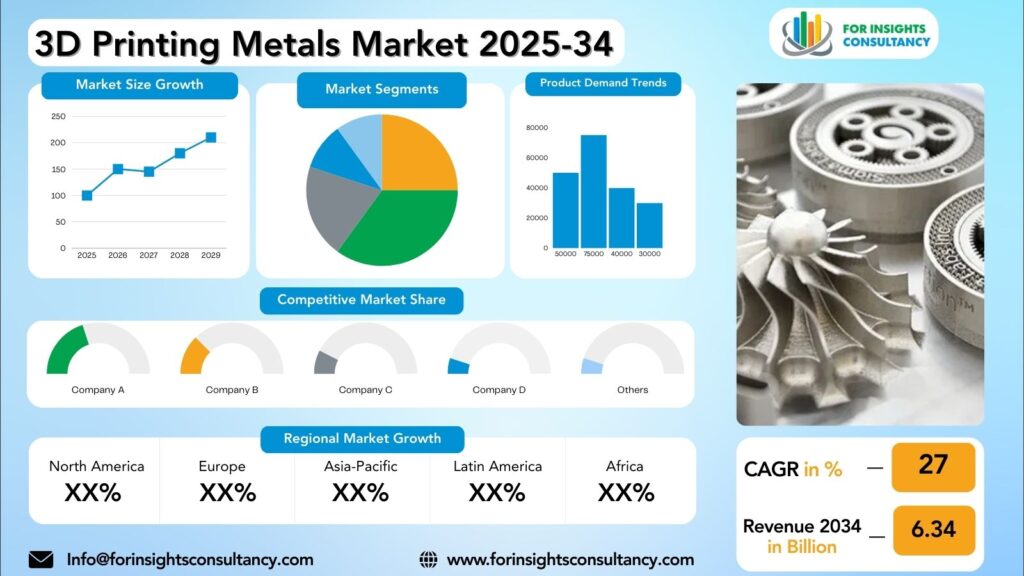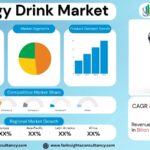
3D Printing Metals Market Research Report by Metal Type (Titanium Alloys, Stainless Steel, Nickel Alloys, Aluminum Alloys,Cobalt Alloys, Other Metals), by Form (Filament, Powder, Others) and, by Technology (Powder Bed Fusion (PBF), Directed Energy Deposition (DED), Binder Jetting, Metal Extrusion), by End-Use Industry (Aerospace & Defense, Automotive, Medical & Dental, Energy, Others), And by Region- Global Forecast to 2034
Aug-2025 Formats | PDF | Category: Chemical & Material | Delivery: 24 to 72 Hours
3D Printing Metals Market Is Expected to See Substantial Growth Over the Forecast Period Between 2025 And 2034, With an Estimated Compound Annual Growth Rate (CAGR) Of Nearly 27%. The Anticipated Growth Is Expected to Push the Market Revenue 2025 $ 1.23 Billion to More Than $6.34 Billion by 2034.
3D Printing Metals Market: A Comprehensive Overview
The mounting uptake of additive manufacturing within metal manufacturing processes is a major contributor to the growth of the 3D printing metals market. Traditional methods of metal fabrication, such as machining or casting, are often more time consuming, expensive, and less flexible when it comes to design comparison to 3D printing. 3D printing allows for the creation of complex geometries in more efficient and precise ways.
There are a number of trends impacting the growth of the 3D printing metals market. One example is the increasing adoption of 3D printing within aerospace and defense industries for producing lightweight, high-performance components. The automotive industry has also entered the venture by using 3D printing for prototyping, tooling, and even end-use parts.
Overall, the outlook of the 3D printing metals market is positive. Continued research and development with the aim of enhancing process efficiencies and material quality indicates that metal additive manufacturing will continue to develop. If the past few years have shown us anything, it is that as the technology improves, becomes cheaper, and easier to access, is a result of a more widespread adoption of the technology.
3D Printing Metals Market Dynamics
Growth Drivers
Technological Advancements: The continuous development of 3D printing technologies has considerably broadened the types of metal materials that can be used for 3D printing. This has enabled better efficiency, lower costs, and better capabilities in producing complex metal parts.
Growing Demand for Customized Products: As consumers are demanding customized products, and manufacturers looking for new efficient ways to manufacture complex components, 3D printing metals is a way for manufacturers to produce customized pieces that can be geometrically complex, at a reasonable cost.
Increasing Adoption in Aerospace and Automotive Industries: The aerospace and automotive industries are increasingly using 3D printing metals to manufacture lightweight, high-strength components, which is causing growth in the demand for metal powder and 3D printing services.
Restraint
High Initial Investment Cost: For companies looking to open a 3D printing metal business, the initial capital to open a facility, including high-quality 3D printing equipment, metal powders, and the organized skilled labor, can be a hurdle for many small and medium-sized businesses trying to enter the market.
Limited Material Options: The available variety of metal materials for 3D printing is increasing; however, there are still limits to the materials that can be used considering the material properties to consider and proper material compatibility that may limit the applications of 3D printing metals to some industry segments.
Quality Control and Certification Challenges: Quality assurance and consistency of 3D printed metadata is challenging, particularly with respect to receiving certifications when required by strategic regulatory authorities because the technology is complex.
Opportunity
Entry into New Industries: The 3D printing metals market can move into new markets such as health care, construction, and consumer goods, which will provide opportunities for growth and diversification.
Development of New Metal Alloys: Research and development focused on developing new metal alloys with better properties such as increased strength, heat resistance, and ductility provides opportunities for innovation and product differentiation.
Customization and On-Demand Manufacturing: The shift toward on-demand manufacturing and customization is expected to accelerate acceptance of 3D printing metals, as companies want to offer customers unique solutions efficiently and cost-effectively.
Challenges
Scalability and Speed of Production: Manufacturers still have challenges around increasing volume and speed of production to satisfy the demands of mass-production 3D printed metal parts.
Regulatory Challenges: Compliance with industry standards, regulations, and certifications for 3D printing metals can be cumbersome and time consuming, especially for companies operating in heavily regulated industries.
Intellectual Property and Security Concerns: Protecting intellectual property rights, preventing unauthorized use of design files, and maintaining data security throughout the 3D printing process A key challenge for the industry.
3D Printing Metals Market Top Companies Covered In This Report:
Evaluate The Strategic Positioning And Innovation Pipelines Of Leading Market Companies-From Multinational Enterprises To Disruptive Regional Firms. Understand How Key Players Are Innovating, Expanding, And Capturing Value, And Use Competitive Benchmarks To Plan Your Next Move.
- Renishaw plc
- Materialise
- Sandvik AB
- EOS GmbH
- Nano Dimension
- Nikon SLM Solutions AG
- 3D
- Stratasys Ltd.
- General Electric Company
- Carpenter Technology Corporation
- Proto Labs
- Titomic
- Hoganas AB
- Forward AM Technologies GmbH
- Pollen AM Inc.
3D Printing Metals Market News
10th April 2024 Materialise and Renishaw announce partnership to increase efficiency of metal 3D printing
Materialise, a global leader in 3D printing software and services, and Renishaw, a global engineering technologies company, have announced a partnership to increase efficiency and productivity for manufacturers using Renishaw’s additive manufacturing (AM) systems. Through the partnership, Renishaw system users will benefit from Materialise’s next-generation build processor software tailored to the RenAM 500 series of metal AM systems. They will also have access to Magics, Materialise’s leading data and build preparation software. This will enable users of Renishaw’s AM systems to build a seamless workflow from design to 3D printed part, control and customise their 3D printing process, reduce production time, and increase the efficiency of their AM operations.
Jul 10, 2024 Sandvik and Desktop Metal jointly meet customer challenges with expertise, binder jetting and Osprey® C18150
When an innovative automotive company wanted to explore what additive manufacturing could do for a specific application, they turned to Desktop Metal’s team of 3D printing experts headquartered in Burlington, Massachusetts, U.S. Kyle Myers, Director of R&D, took the call and started exploring different alternatives right away.
Segmented View of the Industry:
The 3D Printing Metals Market Is Mapped Through A Multidimensional Lens-Tracking Shifts Across Product Type, Applications, And Geographic Regions. This Segmented Approach Enables Businesses To Localize Their Growth Plans And Align Offerings With The Most Profitable Demand Centers.
Segmentation By Metal Type
- Titanium Alloys
- Stainless Steel
- Nickel Alloys
- Aluminum Alloys
- Cobalt Alloys
- Other Metals
Segmentation By Form
- Powder
- Filament
- Others
Segmentation By Technology
- Powder Bed Fusion (PBF)
- Directed Energy Deposition (DED)
- Binder Jetting
- Metal Extrusion
Segmentation By End-Use Industry
- Aerospace & Defense
- Automotive
- Medical & Dental
- Energy
- Others
Global Geographic Coverage:
The Report Provides In-Depth Qualitative and Quantitative Data On The 3D Printing Metals Market For All Of The Regions And Countries Listed Below:
North America
United States
The U.S. is an important market for 3D printing metals, with many manufacturers and a strong research and development environment. The aerospace and defense sector is the primary driver of adoption of 3D printing metals due to the need for lightweight and complex parts.
Canada
The supportive regulatory environment for research and development has allowed large players to enter the region, and the increased demand for customized products and rapid prototyping will allow Canada to experience growth in the market for 3D printing metals.
Mexico
Mexico is a fast-growing 3D printing metals market driven by the automotive and aerospace industries. The country’s close proximity to the United States and lower-cost manufacturing has also made it an ideal region for 3D printing metals. In addition, all Mexican companies, regardless of industry, are considering low-cost manufacturing technologies to improve sustainability, saving energy and reducing waste. 3D printing metals technology allows the production growth capability that matches the emphasis on ‘green’ manufacturing.
Europe
Germany:
Germany is a force to be reckoned with in the 3D printing metals market, having an established industrial base that heavily leverages metal additive manufacturing. EOS GmbH and Concept Laser GmbH have historically been the top companies providing unique additive manufacturing solutions for industries. The automotive and aerospace sectors have benefited tremendously from the application of 3D printing for production of metal parts, allowing for faster foils and tailored designs.
France:
Again, France is following a similar trajectory of other markets in the 3D printing metals space. The country has seen the emergence of startups that have raised financing to further invest in metal additive manufacturing. In addition to startups dedicated to this space, we are also seeing large companies like AddUp and Prodways Group provide pioneering metal 3D printing solutions to the European market.
United Kingdom:
The United Kingdom has ignited a path towards adoption of 3D printing technology for metal manufacturing and subsequently expanded the capabilities offered in various sectors. The medical and dental sectors in the UK have been utilizing 3D printing for metal applications while creating customized items like implants and prosthetics. Key players involved in establishing and expanding the 3D printing metals market in the UK include, but are not limited to: Renishaw and LPW Technology with an emphasis on quality control measures and material optimization, which guarantees consistent product quality.
Asia Pacific
China
China has emerged as the global leader in 3D printing metals internationally, largely due to China’s ongoing investment in research and development of additive manufacturing technologies. China has been going through a period of growth in the 3D printing metals sector as a result of its large manufacturing base and government support and funding of new and innovative projects.
Of all the industries utilizing metal additive manufacturing processes, the aerospace industry has pushed the demand for 3D printed metal products in China. Established aerospace manufacturers, in particular, have made significant investments in metal additive manufacturing technologies which are capable of producing lighter and better performing components than traditional methods of manufacturing.
Another area of growth for China’s 3D printing metals market is expected to be its automotive industry where manufacturing companies have begun utilizing 3D printing metals for prototyping, tooling, and in some cases are producing custom parts. The automotive industry’s embrace of metal additive manufacturing processes should substantially fuel growth in the industry over the next few years.
Japan
Japan is another prominent contributor to the 3D printing metals landscape. Their strength is in precision engineering and high-tech manufacturing. In specific areas – such as material science and metallurgy – their developmental advantages of advanced metals powders for use in additive manufacturing.
Japan’s healthcare sector has been the fastest adopter of 3D printing metals, for patient-specific implants and medical devices. The ability to customize a metal implant through the patients own CT or X-ray scans has been transformative in areas as diverse as orthopaedics and dentistry.
Research institutions and universities have a focus on researching novel metals and alloys for 3D printing, which contributes to the growth of the national market, and also the potential scope of materials we can use in metal additive manufacturing.
South Korea
South Korea has become a significant force in the 3D printing metals market, due to its focus on the development of advanced additive manufacturing applications primarily for aerospace, defense, and electronics sectors. The industrial sector is projected to drive increase in the adoption of metal additive manufacturing materials and examples of metal prototypes have been developed by the country’s key industrial players already.
Leading manufacturing firms in South Korea have begun investing in the use of 3D printing metals in on-demand production of complex parts and components. The aerospace and defense industries also are beginning to see the advantages of metal additive manufacturing for rapid prototyping and low-volume production of critical components such as jigs, fixtures, and spacers.
National governmental innovation incentives including technology adoption initiatives have provided added momentum for the growth of the 3D printing metals market in South Korea generally focusing on the development of new types of materials allied to better processes and applications in additive manufacturing.
Middle East and Africa
Saudi Arabia
Saudi Arabia is a major player in the 3D printing metal markets in the Middle East. The country’s aeropace and defence industries are growing, which increases the demand for 3D printed metal parts. Additionally, the government is promoting additive manufacturing, and this activity is stimulating the metal 3D printing market. The involvement of major companies such as SABIC and Saudi Aramco is also contributing to the growth of the market.
South Africa
The lack of established manufacturers of 3D printed metals is seen as a challenge to the growth in South Africa; however, there is a potential upside in that the regulatory environment is developing. The automotive and healthcare sectors are generating tremendous growth in additive manufacturing and the 3D printed metals space. The growing investment in additive manufacturing solutions/technologies in South Africa will also yield opportunities for growth in the industry given the experience and skills engineers have developed in the traditional manufacturing sectors. The manufacturing sectors in South Africa are established which lessons learned from the manufacturers there play a part in the development of the additive manufacturing because of the manufacturing knowledge of the engineers there and the composite knowledge being gained from working with new technology. In the developing world South Africa will be ahead of its peers because it is embracing innovation and sustainability.
United Arab Emirates (UAE)
The UAE is the leading market for 3D printing metals in the Middle East. The country is diversifying its economy and focusing on advanced manufacturing technologies. The Dubai 3D Printing Strategy and government research and development initiatives have positioned the UAE to grow as an additive manufacturing hub.
Reasons to Buy:
- The Research Would Help Top Administration/Policymakers/Professionals/Product Advancements/Sales Managers And Stakeholders In This Market In The Following Ways.
- The Report Provides 3D Printing Metals Market Revenues At The Worldwide, Regional, And Country Levels With A Complete Analysis To 2034 Permitting Companies To Analyze Their Market Share And Analyze Projections, And Find New Markets To Aim For.
- To Understand The Most Affecting Driving And Restraining Forces In The Market And Their Impact On The Global Market.
- Major Changes And Assessment In Market Dynamics And Developments.
- The Objective Of The 3D Printing Metals Market Report Is To Identify New Business Opportunities Using Quantitative Market Forecasts.
- Formulate Sales And Marketing Strategies By Gaining An Understanding Of Competitors, Their Positioning, And Strengths & Weaknesses.
Faq – What Global Leaders Are Asking
What Is The Growth Prospect For The 3D Printing Metals Market By 2034?
3D Printing Metals Market Is Expected To Achieve A Stable Growth Rate With A Compound Annual Growth Rate (Cagr) Of About 27% From 2025 Through 2034.
What Is Driving The Growth Of The 3D Printing Metals Market?
The growth of the 3D printing metals market is driven by the increasing demand for lightweight, customized, and complex parts from the aerospace, automotive, and medical industries. Additionally, advancements in technology have made 3D printing more cost-effective and capable of producing high-quality components.
Who Are The Key Players In The 3D Printing Metals Market, And What Are Their Market Shares?
The 3D Printing Metals Market Includes Major Companies Like Renishaw plc, Materialise, Sandvik AB, EOS GmbH, Nano Dimension, Nikon SLM Solutions AG, 3D, Stratasys Ltd., General Electric Company, Carpenter Technology Corporation, Proto Labs, Titomic, Hoganas AB, Forward AM Technologies GmbH, Pollen AM Inc.
Specific Market Share Data Is Not Publicly Available And Is Typically Provided In Detailed, Proprietary Market Research Reports.
Which Regions Are Leading The 3D Printing Metals Market Growth?
North America currently leads the 3D printing metals market, driven by a strong industrial base and early adoption in aerospace and defense sectors. The Asia-Pacific region, however, is the fastest-growing market due to rapid industrialization, increasing government investments, and a growing manufacturing sector in countries like China and India.
Customization: We Can Provide Following Things
1) On Market More Company Profiles (Competitors)
2) Data About Particular Country Or Region
3) We Will Incorporate The Same With No Additional Cost (Post Conducting Feasibility).
Any Requirement Contact Us: Https://Www.Forinsightsconsultancy.Com/Contact-Us/
Table of Contents
For TOC Contact us: https://forinsightsconsultancy.com/contact-us/






